Powderpost beetles pests are second only to termites when it comes to causing damages to structures. Their havoc could be just as severe.
What is a powderpost beetle? A powderpost beetle is several species of woodboring beetles that can infest homes. Its group is known to attack woods—both structural and furniture and make holes in them. The female powderpost beetles lay eggs upon these pores and wait for the larvae to hatch from their eggs.
Once the eggs are hatched, the larvae will start to feed on woods and create multiple holes as they go. They’ll then mature and transform into pupae to adult beetles and tunnel their way out of the wood.
What Is a Powderpost Beetle?
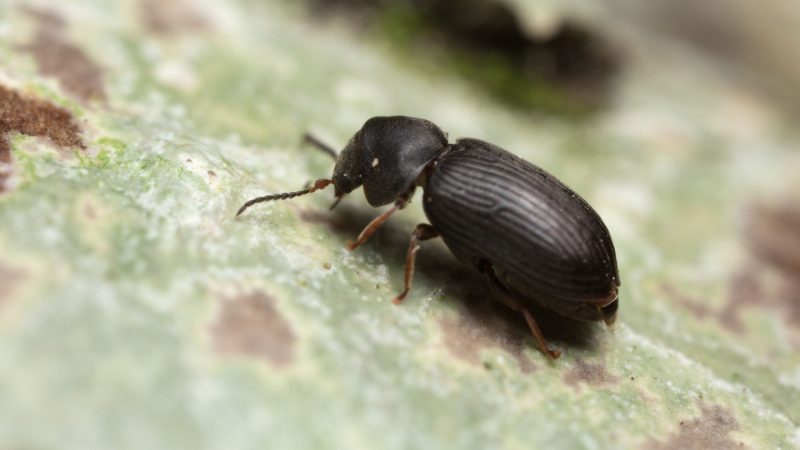
As discussed above, powderpost beetles are several species of woodboring beetles. This beetle species holds the three most destructive groups —anobiids, bostrichids, and lyctids.
Here are the three most destructive groups of this beetle species:
Anobiid Powderpost Beetles
Anobiids are reddish to dark brown beetles that feed both hardwoods and softwoods. These beetles can seriously damage beams, joists, and other fundamental parts of buildings.
These powderpost beetles are more destructive compared to bostrichids and lyctids. They love to infest moist wood, and their infestation is commonly found in:
- Damp crawl spaces
- Garages
- Basements
- Unheated buildings
- Attics
Bostrichids
Bostrichids are reddish-brown to black beetles, having less narrow bodies than lyctids. Their heads have tiny, rasp-like bulges and are turned downwards.
Lyctids
Lyctids have the same color as bostrichid and anobiids. They have narrow and elongated bodies with round emergence holes.
These powder post beetles are known to only nibble on hardwood manufactured products, such as:
- Oak
- Walnut
- Hickory
- Ash
- Cherry
- Poplar
They can be found infesting on window and door frames, molding, furniture, flooring, and paneling made from wood.
Each of the three groups has several species that can damage wood materials. Worse, their life cycle completion takes two to five years, which means they’ve been eating the wood parts of your home for those years.
Wood Types That Some of Powderpost Beetles Eat
Like termites, some of these beetles feed on the following wood types:
- Oak
- Ash
- Walnut
- Bamboo
- Hickory
- Pine
Do Powderpost Beetles Fly?
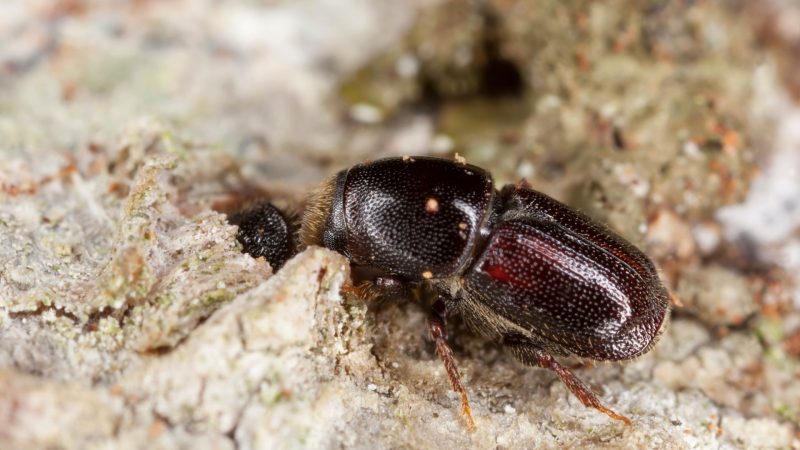
Powderpost beetles can fly. They’re strong fliers and usually found gathering around the windows and lighted areas as they’re attracted to lights.
Furthermore, these beetles love to fly around homes to seek a better place where they can lay their eggs. Thus, it’s best to stay vigilant and act right away once you see them flying over your house.
Does Powderpost Beetle Make Noise?
Powderpost beetles do make clicking noises, particularly the larvae. Once you hear these clicking noises, it’s a sign that an infestation is upon your home.
How Would You Know if You Have an Infestation?
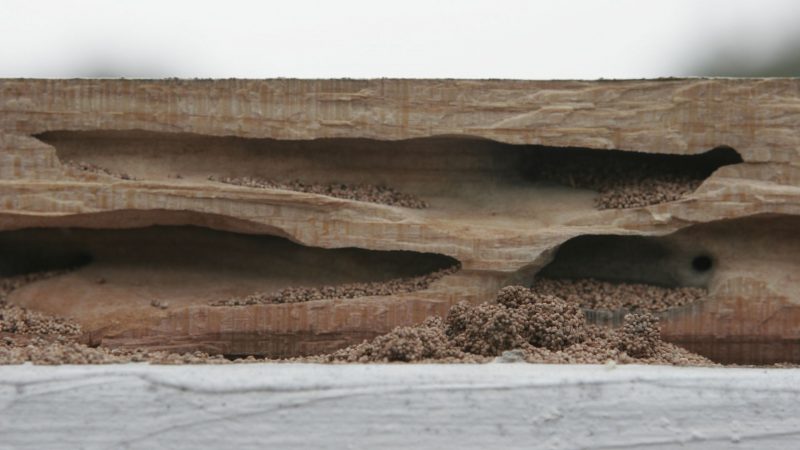
One of the ways you’ll know that you have an infestation is by seeing the frass they leave behind. Frass is a mixture of minuscule wood particles and larvae excrement, falling from the holes made by the adult beetles when they surface.
The frass can resemble flour, baby powder, or cornmeal, depending on their species. Moreover, you can also confirm an infestation when you hear clicking sounds on the holes of your wood materials.
To effectively determine the residue you find in your home, you may opt to hire a local pest control professional. Pest control experts have extensive knowledge about pests and can give you the best possible solution for your pest problem.
Where to Spot Infestations of Powderpost Beetles?
Considering nearly all home frames are crafted from softwoods, distinct powderpost beetles species can cause structural damage to residences. Though most of their damage can’t be seen, you can spot infestations in the following areas:
- Wood paneling
- Window frame
- Door frame
- Crown molding
- Wood furniture
- Hardwood floors
- Plywood
So, it’s always best to keep an eye on these pests and act right away when you spot them on your property.
What Kind of Damage Do Powderpost Beetles Cause?
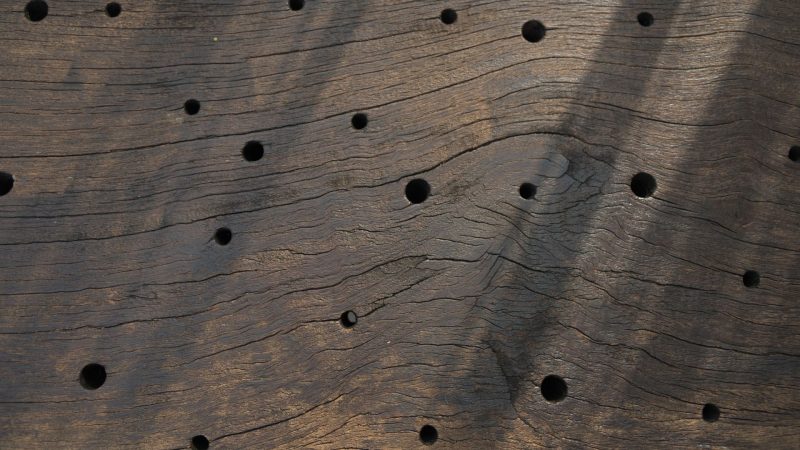
Powderpost beetles can bore holes into the wood material of your home. They can also reduce your wood to a flour-like powder.
These beetles inflict damage by creating narrow, meandering tunnels as they feed on the wood material of your house. Thus, it’s essential to take prompt action to prevent hefty damages to your property.
Are Powderpost Beetles Worse Than Termites?
Powderpost beetles aren’t as bad as termites. Termites still have the first place in destroying structures as they infest in large numbers.
Moreover, termites don’t get out of the wood until they’ve eaten the whole wood from the inside. Meanwhile, powderpost beetle larvae get out once they run into adults.
For such given reasons, it’s clear that termites are much worse compared to powderpost beetles. However, never take these pests for granted, as they can also cause severe damage to your property.
Powderpost beetles, particularly anobiid powderpost beetles, are nasty destroyers. They can re-infest the same wood after turning into an adult, ensuring the destruction of your wood material.
Related: How to Get Rid of Subterranean Termites? | Control and Prevention
How to Treat Powderpost Beetles in House?
To effectively treat powderpost beetles in your house, you must reduce the moisture content of your wood materials. You need to ensure your home has good ventilation or vapor barriers.
You can monitor the moisture level of your wood by using moisture meters to ensure that your wood has less moisture left in them. Furthermore, you can also varnish or sand your wood furniture to make it less attractive to these wood-nibbling creatures.
How to Get Rid of Powerderpost Beetles?
To get rid of these beetles, you may try to use the following:
Bora-care
You may also opt to use bora-care insecticide to get rid of powderpost beetles within your home. To do this:
Step 1: Mix five gallons of water to one gallon of bora-care for two applications.
Step 2: Apply the solution on all wood surfaces by using a spray, mist, or brush.
Step 3: Wait for 20 minutes before reapplying for the second coat.
Note: Make sure to read the product’s label for safe and effective use.
- WOOD TREATMENT FOR MAXIMUM PROTECTION: Bora-Care penetrates deep...
- FAST AND EASY APPLICATION: Applies directly to wood surfaces with...
- IDEAL FOR NEW AND EXISTING CONSTRUCTION: Perfect for use in both...
- ENVIRONMENTALLY FRIENDLY: Protects your home without pumping...
- LONG-LASTING RESIDUAL PROTECTION: Once applied, Bora-Care remains...
Timbor
is a powder insecticide that can help you eliminate powderpost beetles. To make a solution out of timbor:
Step 1: Mix the timbor powder with water.
Step 2: Get a gallon of water and put the 1.5 lb pouch in it.
Step 3: Once the mixture is done, spray it to the affected area.
This insecticide solution is known to last for several years, making it a good option to exterminate and prevent woodboring beetles from re-infesting.
Another option you have is to call a local pest control professional to resolve your woodboring beetles’ problems effectively.
No products found.
How Much Does It Cost to Treat Wood Beetles?
According to HomeAdvisor, the wood beetle treatment can cost around $1,500 to $5,000, depending on the extent of the damage.
How Long Does Powder Post Beetle Treatment Last?

This depends on the treatment used. For example, if you opt for for treatment, it can last for several years. Meanwhile, bora-care can last up to 12 years.
How Do You Eliminate Powderpost Beetles Naturally?
To get rid of powderpost beetles naturally, you may opt for the following methods:
Freezing
Freezing is one the most effective ways to get rid of woodboring beetles naturally. Just take out the wood where they live, put them in a tightly knotted plastic bag, and put them in the freezer for at least 72 hours.
Using Kiln or Furnace
Another way to naturally get rid of powderpost beetles is by using a kiln or furnace. Just get the infested materials and place them on a furnace or kiln.
This process will remove the moisture from your wood materials that woodboring beetles love so much. However, this method is only good to a limited extent.
After the materials are thoroughly dry, seal the object by covering it with paint.
Install Moisture Barrier
By installing a moisture barrier, you can reduce air levels, effectively controlling moisture. It also helps limit the survival of these beetles.
Moisture barriers help increase the ventilation levels of your home and are best placed near the location of the infestation.
Sprinkling Borate Salt
Sprinkling borate salt is one of the many ways to get rid of woodboring beetles. However, this solution isn’t that effective if you have thick wood structures.
This method is only highly effective if placed over thin wood.
Infested Wood Replacement
Replacing your infested wood is also a good option. Although this can cost money, it can be a good choice considering the amount you’ll have to pay when the problem gets worse.
Essential Oil Spray Application
One of the most economical ways to get rid of powderpost beetles is through using essential oil spray. You can use eucalyptus, basil, cedar oil, or tarragon.
These oils can effectively aid in eliminating woodboring beetles at home and in gardens. Make sure to spray one of these oils for three consecutive days to get rid of the nuisances in your place.
Can Exterminators Get Rid of Powderpost Beetles?
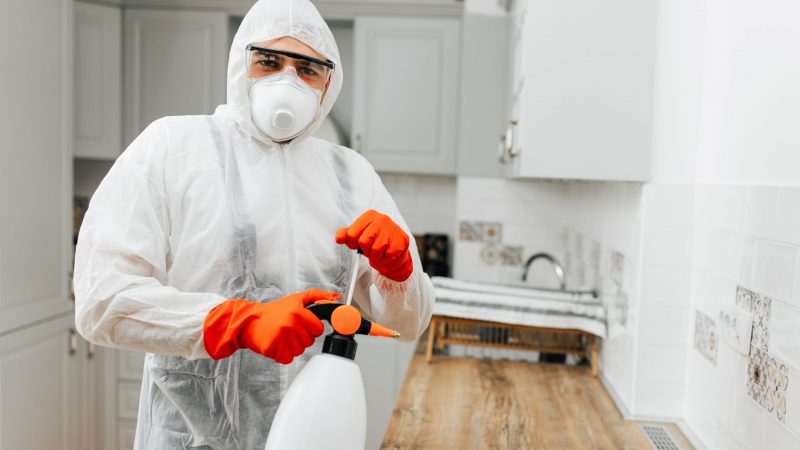
Exterminators can get rid of powderpost beetles effectively. They have several ways of exterminating pest problems accordingly and ensuring the safe and effective use of chemicals.
For example, when an infestation is large, it may require fumigation. Executing fumigation is best done by a licensed pest control expert to ensure safety and efficacy.
How to Cover Powderpost Beetle Holes?
To cover powderpost beetle holes:
Step 1: Prepare wood glue and sawdust.
Step 2: Fill the gap with wood glue and rub sawdust into the hole.
Step 3: It’s best to use the sawdust from the wood you’re working on to ensure a matching color.
Step 4: After rubbing the sawdust, get fine-grade sandpaper and use it to finish the repair.
Do Powderpost Beetles Go Away on Their Own?
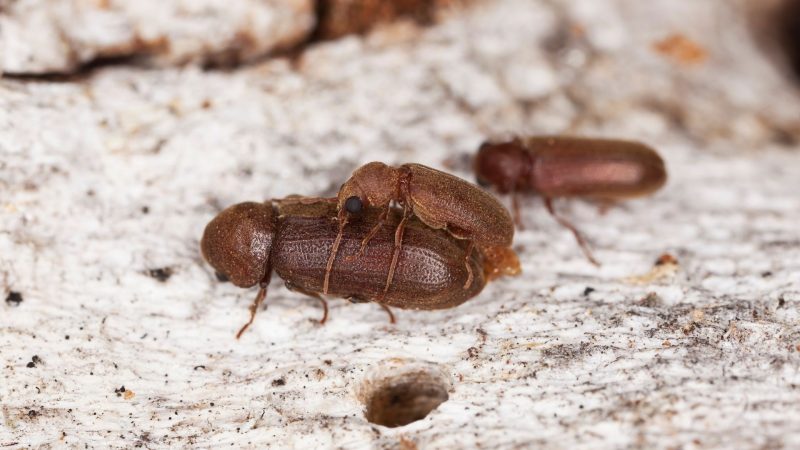
Powderpost beetles often go away on their own accord. This is why it’s essential to know if you have an active infestation or not before taking any action.
Checking first for active infestation before doing anything can help you save time and money in the process. If you saw fresh sawed-like powder around wood holes, it’s a sign that you have an active infestation at your place.
Summary
Powderpost beetles or woodboring holes are the second-most destructive pests to termites. They’re known to infest on woods and leave holes in them, leaving your structure vulnerable.
Thus, it’s important to take action once an active infestation is confirmed. In this way, you can prevent dealing with hefty damages in the future.
Related: Top 10 Worst Pests That Can Infest Your House | Identification and Control Guide
List of Sources
Lewis, V. et al. (2010). How to Manage Pests – Pests of Homes, Structures, People, and Pets: Wood-Boring Beetles in Homes. University of California.
Potter, M. (2018). Powderpost Beetles. University of Kentucky.
Powderpost Beetles. (2021). University of Maryland.
Powderpost Beetles. Iowa State University.
Suomi, D. (2006). Anobiid Beetles in Structures: Insect Answers. Washington State University.
- How to Get Rid of Copperheads | Practical Guide - August 27, 2023
- How to Get Rid of Corn Snakes | What Makes Them Aggressive? - August 27, 2023
- How to Get Rid of Alligators | Safety Measures and Removal Methods - July 16, 2023

